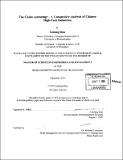| dc.contributor.advisor | Michael Cusumano. | en_US |
| dc.contributor.author | Bian, Leiming | en_US |
| dc.contributor.other | System Design and Management Program. | en_US |
| dc.coverage.spatial | a-cc--- | en_US |
| dc.date.accessioned | 2006-11-07T13:38:46Z | |
| dc.date.available | 2006-11-07T13:38:46Z | |
| dc.date.copyright | 2005 | en_US |
| dc.date.issued | 2005 | en_US |
| dc.identifier.uri | http://hdl.handle.net/1721.1/34627 | |
| dc.description | Thesis (S.M.)--Massachusetts Institute of Technology, System Design and Management Program, 2005. | en_US |
| dc.description | Includes bibliographical references (p. 119-121). | en_US |
| dc.description.abstract | The emergence of China as a rising economic power has surprised many pundits and commentators around the world. It first gained its status as one of the largest manufacturing centers in the world, creating companies from toy makers to networking gear manufacturers, which successfully used their low cost advantage to compete against firms based in developed countries. As western countries including the U.S. started to attribute China's success to the abundance of low cost labor, a few Chinese firms rose up to challenge the dominance of multinational corporations. In the high-tech industries, in particular, some firms have started to combine their low wage advantage with sophisticated end-to-end strategies by ramping up competencies in important areas in the value chain, including research and development, manufacturing and supply chain management, marketing, and strategy. This thesis examines the competitive advantage and disadvantage of Chinese high-tech industries by studying a number of firms in the information technology sectors. | en_US |
| dc.description.abstract | (cont.) It demonstrates that the competitive advantages of those industries include low cost structures, a pool of highly skilled engineers and scientists, a sophisticated science and technology infrastructure, a growing domestic market with enormous potential, and a cluster of related high-tech industries that benefit each other. The thesis also reveals that most Chinese high-tech firms still lack financial capital, brand recognition, talents, managerial competencies, and technological capabilities. The thesis concludes by offering a set of recommendations to Chinese high-tech firms to help them become more respectable global players. In the meantime, this work also proposes a different set of strategies that US high-tech firms can use to gain the "next" innovative advantage in this extremely competitive global business environment. | en_US |
| dc.description.statementofresponsibility | by Leiming Bian. | en_US |
| dc.format.extent | 121 p. | en_US |
| dc.format.extent | 6350792 bytes | |
| dc.format.extent | 6358225 bytes | |
| dc.format.mimetype | application/pdf | |
| dc.format.mimetype | application/pdf | |
| dc.language.iso | eng | en_US |
| dc.publisher | Massachusetts Institute of Technology | en_US |
| dc.rights | M.I.T. theses are protected by copyright. They may be viewed from this source for any purpose, but reproduction or distribution in any format is prohibited without written permission. See provided URL for inquiries about permission. | en_US |
| dc.rights.uri | http://dspace.mit.edu/handle/1721.1/7582 | |
| dc.subject | System Design and Management Program. | en_US |
| dc.title | The China advantage : a competitive analysis of Chinese high-tech industries | en_US |
| dc.title.alternative | Competitive analysis of Chinese high-tech industries | en_US |
| dc.type | Thesis | en_US |
| dc.description.degree | S.M. | en_US |
| dc.contributor.department | System Design and Management Program. | en_US |
| dc.identifier.oclc | 71441670 | en_US |
